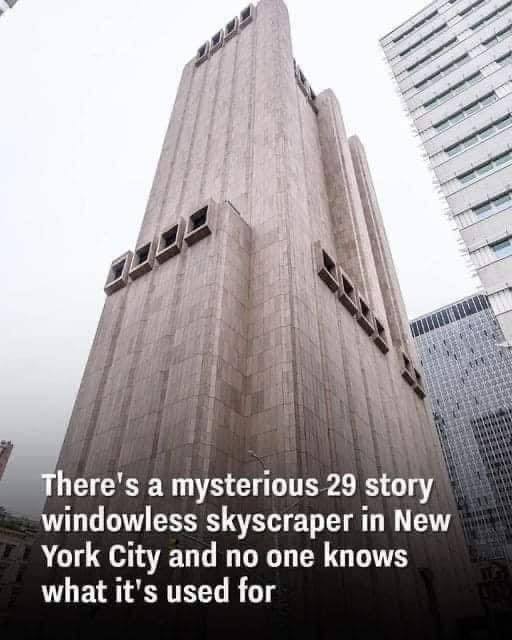Standing tall and silent in Lower Manhattan is one of New York City’s most mysterious structures—33 Thomas Street, also known by its codename “Titanpointe.” This 29-story skyscraper stretches 550 feet into the air, built entirely from concrete and granite, and most notably, it lacks a single window. Its dark, fortress-like appearance sets it apart from the surrounding buildings, giving off an eerie presence whether it’s casting long shadows in the daylight or standing pitch-black under the night sky.

Designed in 1974 by the architectural firm John Carl Warnecke & Associates, the building was originally constructed to house telecommunications infrastructure and serve as a secure site that could withstand a nuclear blast. Meant to protect vital communication systems, its brutalist design prioritized security over aesthetics. But despite its visible location and towering presence, 33 Thomas Street has remained a subject of intense curiosity and speculation. Referred to by some as the “Long Lines Building,” its true function has long been cloaked in secrecy. That changed when documents leaked by former NSA contractor Edward Snowden shed light on the building’s possible covert purpose.
According to these revelations, along with supporting blueprints and interviews with former AT&T employees, 33 Thomas Street may have been more than just a telephone hub. It was reportedly used by the National Security Agency as a surveillance center, operating under the name Titanpointe. Inside the building lies a major international gateway switch that routes a large portion of the world’s phone communications. Intelligence analysts believe the NSA tapped into this infrastructure to monitor international calls, including those connected to global institutions such as the United Nations, the International Monetary Fund, and the World Bank, as well as to both adversarial and allied foreign governments.
The building’s heavily fortified design, restricted access, and strategic location all support the theory that it played a central role in government surveillance efforts. While the relationship between AT&T and the NSA has been documented for years, the Snowden leaks provided more specific details about how deeply the two organizations may be intertwined—especially in New York City. These disclosures suggest that the NSA had access to AT&T’s network through equipment embedded within facilities like 33 Thomas Street. Still, there has been no official confirmation that the NSA operated directly out of the building, and AT&T has largely declined to comment on the matter.
However, what is known is that AT&T owns most of the space within the skyscraper, with Verizon holding a smaller portion. This deep collaboration between a private communications provider and a federal intelligence agency raises serious concerns about privacy and oversight. As Elizabeth Goitein, co-director of the Liberty and National Security Program at the Brennan Center for Justice, points out, this situation demonstrates how companies we rely on for communication have effectively become extensions of government surveillance operations. She emphasized that the assumption that surveillance only targets non-U.S. citizens is becoming harder to justify given these revelations.
The building, once simply a curiosity due to its windowless design, now represents a symbol of modern surveillance. It stands as a reminder of the growing tension between the need for national security and the right to personal privacy. The possibility that a structure so deeply embedded in the fabric of a major city could also serve as a gateway for mass data collection prompts a reexamination of how transparent and accountable our intelligence systems truly are. Even though there is no conclusive proof that the NSA directly utilized 33 Thomas Street, the circumstantial evidence and expert analysis leave little doubt in the minds of many. The New York Times and ProPublica reported in 2015 that AT&T had a long history of cooperation with the NSA and had been highly praised for its willingness to assist.
Yet, Snowden’s files stopped short of definitively linking the agency to operations inside the building. Whether Titanpointe was a central node in one of the largest surveillance systems in the world or simply a secure telecom hub, its story continues to stir debate. In the end, 33 Thomas Street represents more than just a strange-looking skyscraper—it embodies the complexities of living in an era where advanced technology allows for unprecedented surveillance, often without the knowledge or consent of the public. As our digital lives continue to grow, the conversation around security, privacy, and the spaces in which those lines blur becomes increasingly important. This windowless tower remains both a physical and symbolic monument to the hidden layers of communication in the modern age.





